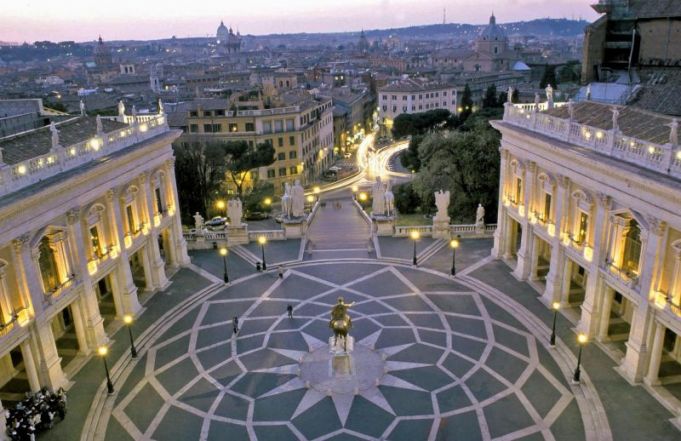Please wait ...
The Capitoline Museums is a single museum containing a group of art and archaeological museums in Piazza del Campidoglio, on top of the Capitoline Hill in Rome, Italy. The historic seats of the museums are Palazzo dei Conservatori and Palazzo Nuovo, facing on the central trapezoidal piazza in a plan conceived by Michelangelo in 1536 and executed over a period of more than 400 years.

The statue of a mounted rider in the centre of the piazza is of Emperor Marcus Aurelius. It is a copy, the original being housed on-site in the Capitoline museum. Opened to the public in 1734 under Clement XII, the Capitoline Museums are considered the first museum in the world, understood as a place where art could be enjoyed by all and not only by the owners.
This section contains collections sorted by building, and brief information on the buildings themselves. For the history of their design and construction, see Capitoline Hill Michelangelo. The Capitoline Museums are composed of three main buildings surrounding the Piazza del Campidoglio and interlinked by an underground gallery beneath the piazza.

The three main buildings of the Capitoline Museums are:
Palazzo Senatorio, built in the 12th century and modified according to Michelangelo's designs, Palazzo dei Conservatori, built in the mid-16th century and redesigned by Michelangelo with the first use of the giant order column design, and Palazzo Nuovo, built in the 17th century with an identical exterior design to the Palazzo dei Conservatori, which it faces across the palazzo.
2nd floor
The second floor of the building is occupied by the Conservator's Apartment, a space now open to the public and housing such famous works as the bronze she-wolf nursing Romulus and Remus, which has become the emblem of Rome. The Conservator's Apartment is distinguished by elaborate interior decorations, including frescoes, stuccos, tapestries, and carved ceilings and doors.
3rd floor
The third floor of the Palazzo dei Conservatori houses the Capitoline Art Gallery, housing the museums' painting and applied art galleries. The Capitoline Coin Cabinet, containing collections of coins, medals, jewels, and jewelry, is located in the attached Palazzo Caffarelli-Clementino.

Palazzo Nuovo
Statues, inscriptions, sarcophagi, busts, mosaics, and other ancient Roman artifacts occupy two floors of the Palazzo Nuovo. In the Hall of the Galatian can also be appreciated the marble statue of the "Dying Gaul" also called “Capitoline Gaul” and the statue of Cupid and Psyche. Also housed in this building are: The colossal statue restored as Oceanus, located in the museum courtyard of this building, A fragment of the Tabula Iliaca located at the Hall of the Doves, The statue of Capitoline Venus, from an original by Praxiteles (4th century BC).

The wounded Amazon, copy from original work by Phidias
Galleria Congiunzione
The Galleria Congiunzione is located beneath the Palazzo dei Conservatori and the piazza itself, and links the three palazzos sitting on the piazza. The gallery was constructed in the 1930s. It contains in situ 2nd century ruins of ancient Roman dwellings, and also houses the Galleria Lapidaria, which displays the Museums' collection of epigraphs.
The Centrale Montemartini is a former power station of Acea (active as a power-station between the 1890s and 1930s) in southern Rome, between Piramide and the basilica of San Paolo Fuori le Mura, close to the Metro station Garbatella.

Baby Herakles strangling a snake sent to kill him in his cradle
In 1997, the Centrale Montemartini was adapted to temporarily accommodate a part of the antique sculpture collection of the Capitoline museums, at that time closed for renovation; the temporary exhibition was so appreciated that the venue was eventually converted into a permanent museum.

Its permanent collection comprises 400 ancient statues, moved here during the reorganisation of the Capitoline Museums in 1997, along with tombs, busts, and mosaics. Many of them were excavated in the ancient Roman horti (e.g. the Gardens of Sallust) between the 1890s and 1930s, a fruitful period for Roman archaeology. They are displayed there along the lines of Tate Modern, except that (unlike there) the machinery has not been moved out.

Roman Trophy displayed inside the Musei Capitolini courtyard